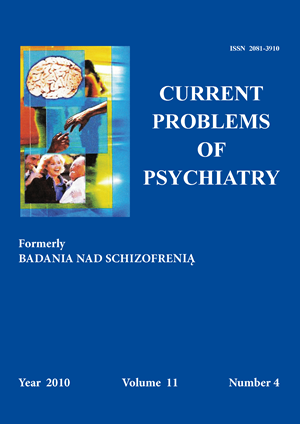Diagnosis difficulties of Fahr’s syndrome – case report
Keywords:
Fahr’s syndrome, idiopatic intracranial calcifications, basal gangliaAbstract
The aim of the paper was to present the diagnostic difficulties related to the diagnosis of Fahr syndrome. Accurate diagnosis requires extensive research, starting with an interview, through a clinical evaluation, the implementation of psychological tests, to a variety of additional tests and imaging.
The paper is a description of the psychopathological picture, course of illness and subsequent stages of diagnosis of two patients with the diagnosis of Fahr syndrome hospitalized in the Department of Adult Psychiatry, Medical University of Lodz in 2009.
The diagnosis of Fahr's syndrome can not be based solely on clinical picture, it is only an indication to perform a thorough diagnostic imaging. The study of choice is the CT of the head with the assessment of intracranial calcification foci. The studies with fluorodeoxyglucose PET, SPECT using 99mTc-HMPAO are also useful.
References
1. Cummings J.L., Mega M.S. Zaburzenia czynności ruchowych, In: Rydzewski M. ed., Neuropsychiatria, Wrocław; Urban&Partner; 2005, pp. 269-306.
2. Fahr T. Idiopathische Verkalkung der Hirgefasse. Zentrablatt Allgemeine Pathologie, 1930.
3. Kygur G.A., Lin Y., Hellman R.S. Evaluation of regional cerebral blood flow in Massive Intracerebral Clacifications. J. Nucl. Med., 1995; 36: 610-612.
4. Heymann-Szlachcińska A., Kisielewski J., Rybakowski J. Zaburzenia neurokognitywne u chorej z zespołem Fahra. Wiad.Psychiatr., 2004; 1: 35-38.
5. Geschiwind D.H., Loginor M., Stern I.M. Identyfication of a locus on chromosome 14q for idiopatic basal ganglia calcification (Fahr disease). Am. J. Hum. Genet., 1999; 65(3): 764-772.
6. Laskowska I., Ciesielski M., Gorzelańczyk E.J. Udział jąder podstawy w regulacji funkcji emocjonalnych. Neuropsychiatria i Neuropsychologia, 2008; 3: 107-115.
7. Kotan D., Augul R. Familial Fahr disease in a Turkish family. South Med. J., 2009; 102(1): 85-86.
8. Ones T., Dede F., Gunal D. The clinical utility of 99m-TcHMPAO SPECT in Fahr disease. Ann. Nucl. Med., 2008; 22(5): 425-428.
9. Lam J., Fong S., Yiu G.C., Wing Y.K. Fahr’s disease: a differential diagnosis of frontal lobe syndrome. Hong Kong Med. J., 2007; 13: 75-77.
10. Lazar M., Ion D.A., Streinu-Cercel A., Badarau A.I. Fahr’s syndrome: diagnosis issues in patients with un-known family history of disease. Rom. J. Morphol. Em-bryol., 2009; 50(3): 425-428.


